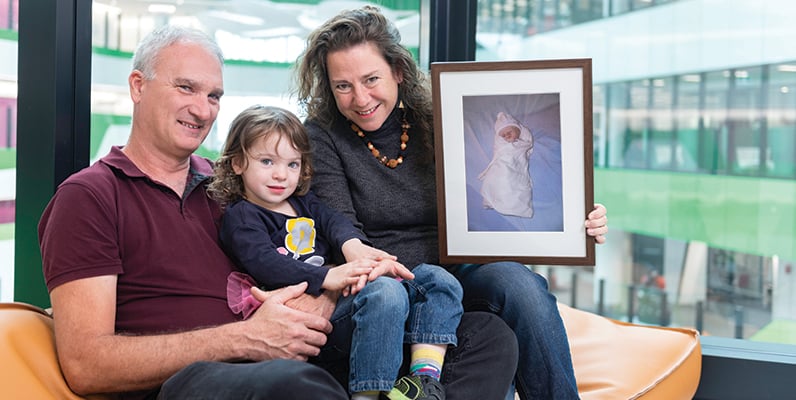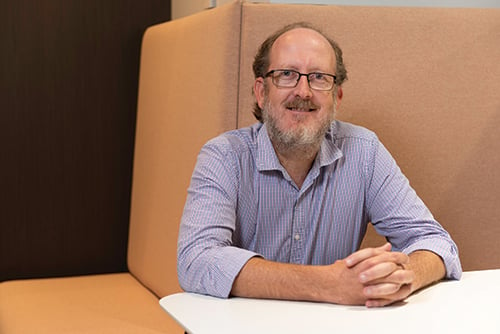
Brad, Jaime and Djuna
Telethon Kids Institute researchers believe a public education campaign, like the one around Sudden Infant Death Syndrome (SIDS), would help to reduce the number of babies who are stillborn.
Research shows that deaths from SIDS in Australia dropped from 500 in 1989 to 113 cases in 2015, following the ‘reduce the risks campaign’ linking babies’ face-down sleep position to increased risk of SIDS.
Telethon Kids Institute researcher Carrington Shepherd said that nationally, six babies were stillborn each day and, like SIDS, some of those deaths were preventable. There was a ‘tragic over-representation’ of Aboriginal people in those figures.
“But there’s a real sense of fatalism that stillbirth is unavoidable, that it’s not preventable – and that’s not true,” Dr Shepherd said.
“However, we don’t fully understand which deaths are avoidable and which aren’t, and this really hampers our work in this space.”
Dr Shepherd has teamed with the Institute’s Dr Brad Farrant to lead further research on the topic. Dr Farrant and his wife Jaime are parents to daughter Kaya, who died unexpectedly during labour in 2011.
Dr Farrant said he believed Kaya’s death – from a combination of infection and intrauterine growth restriction – was among those that were preventable.
“It’s still a very stigmatised space,” Dr Farrant said. “The public understanding around stillbirth is quite low, with a lot of myths.
“There’s much work to be done in public health education to create an environment where we are able to have adult conversations around what we need to do to reduce stillbirth.”
The Farrants gave evidence to the Australian Senate Select Committee on Stillbirth Research and Education in December 2018, and Dr Farrant said the time was now right, in the wake of that inquiry, to ramp up research.

Accordingly, he and Dr Shepherd are developing a small team of researchers at Telethon Kids and nurturing broader collaborations with the University of South Australia and the stillbirth charity Still Aware. Together they have formed the Stillbirth Parents, Educators, Awareness advocates and Researchers (SPEAR) collaboration.
Dr Shepherd said improving available data was a crucial first step in helping researchers.
“At the moment we are all coming from different angles; we have data boffins, clinical researchers, and scientists all working separately with their part of the picture, but if we could combine that we’d get a clearer picture of what needs to be done,” he said.
“Then, we’d like to have that information linked to other administrative data and available to third party researchers like us.”
“The data needs to be better. Placental dysfunction is one of the biggest risk factors for stillbirth, yet we don’t systematically collect data about it. We’d like to see more information collected through autopsy processes and we’d like to see that happen systematically.”
Dr Farrant said a big focus would be having a national conversation about stillbirth the way the community had previously had around SIDS.
“The parallels with SIDS are instructive,” he said. “One of the key factors in the SIDS campaign was raising public awareness around sleeping position, and maternal sleeping position has been identified as a factor in stillbirth – so there are strong parallels.
“The SIDS campaign was very effective in not just raising awareness and dispelling myths but in getting people’s interest.
“We need to do what we can to get people talking about stillbirth – this could be one of the most important things we do in terms of prevention.”
What's next
-
A national public education campaign.
-
A nationally co-ordinated approach to data collection.
-
Ramping up examination of placental dysfunction as one of the big risks in stillbirth.
Putting parents at the fore
It was a conversation between The Kids Research Institute Australia researcher Brad Farrant and University of South Australia PhD student Danielle Pollock, at the International Stillbirth Alliance Conference in Scotland last year, that gave rise to the group SPEAR: Stillbirth Parents, Educators, Awareness advocates and Researchers.
The pair joined up with The Kids researcher Dr Carrington Shepherd, Claire Foord, founder of charity Still Aware, and Associate Professor Jane Warland, of the School of Nursing and Midwifery at the University of South Australia, to form the group, which aims to ensure that the voices of bereaved parents are heard in stillbirth policy, research and ultimately practice.
Dr Farrant, Danielle Pollock, Claire Foord and Jane Warland have all personally experienced stillbirth in their lives, with their experiences as bereaved parents a key driver as they seek to change the conversation around stillbirth.
Dr Farrant said that for him, the most important function of the group – which was still in its early days – was public education.
“Not long ago, it was thought the best thing for bereaved parents was to have the baby taken away and never spoken of again,” he said.
“Thankfully, through a concerted advocacy and education campaign this is no longer the case. Unfortunately there is still a lot of stigma and lack of understanding about stillbirth, and this is why public education is such a vital component of stillbirth prevention.
“Conversations need to happen to educate the public, and it’s important that the voices of bereaved parents are ‘front and centre’ of those conversations.”
